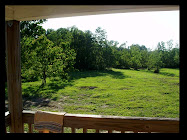Earlier in the spring when the weather was a bit cooler, Callum and I were walking around the field and made our way over to one of the tallow tree circles (I'll tell you about these in just a minute). The trees had just begun blossoming and as we neared the trees we heard a constant electric hum. Upon closer inspection I saw that the trees were buzzing with wild honeybees! This is quite a reassuring sound amid reports of declining honeybee populations.
The American honeybee is a welcome presence in any garden and the long, golden, chain-like flowers of the Tallow are a honeybee favorite.

Any Tallow management project would have to take into account the benefit of these trees for wildlife. Not only do the bees love'em, but the birds do too. Of course, the birds end up being part of the problem when they spread the seeds to surrounding natural areas.
It is most likely that our project on the farm would be a management project rather than eradication. The Tallow tree problem in some southern states has gotten to the point where landowners are advised by the state to remove these trees from their property entirely. However, as young and energetic as I am, I can't imagine the cost and energy required to rid the property of these trees (nor do I want to think about all the herbicide that would have to be used if we found ourselves forced to take that route).

Here is an idea of what we are dealing with. The picture above is the property immediately in front of our house. Every tree you see, besides the lonely maple sapling up in front, is a Tallow. While the cows were here, they grew up along the fence lines. The "Tallow Tree Circles" are 3 big circles next to our house where the trees were cut down and piled up about 20-30 years ago. The area was not mowable because of the huge debris pile, and the seeds of the "debris" trees were able to germinate and grow undisturbed. In the back of the property where there are still a few old oaks, gum, pine and maple growing, the Tallow is busy taking over the understory and competing with the younger versions of these already established trees.
Ultimately it would be nice just to clear out patches of these trees at a time and establish and nurture the growth of other species that are equally hospitable to the wildlife. It would probably be a good idea to start with the areas where seedlings of other species are already trying to establish themselves. Help those along first, and clear out the Tallow competition. Later, we could move on to the mini Tallow forests themselves.
We are still thinking of ways to approach this issue, and any suggestions or feedback are certainly appreciated!






No comments:
Post a Comment